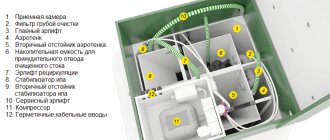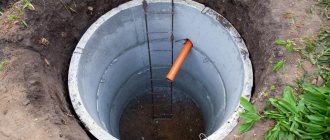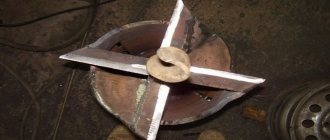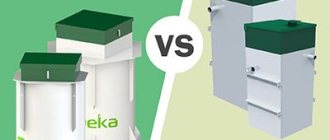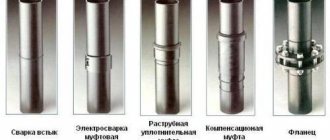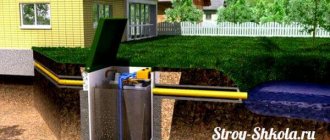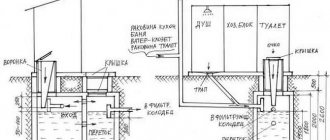A new product among Russian-made VOCs is the AK-47 septic tank. The equipment is distinguished by trouble-free operation in any climatic conditions and high efficiency of household wastewater treatment. The station meets all safety requirements, does not require expensive maintenance and services of vacuum cleaners, and its cost is 30% lower than products of a similar class.
The sewer cleaning process takes place in one container, its full cycle takes 24 hours. This technology is called SBR, it is popular in European countries. The SBR reactor consistently carries out a program to remove organic matter, nitrogen and phosphorus from the effluent. The cleansing phases are separated in time and occur in one chamber. The operation of the station is controlled by a microprocessor, which will promptly report any problem or failure in the system.
Construction of a septic tank AK-47
Autonomous sewage system is manufactured in a sealed plastic container, the useful volume of which, depending on the model, ranges from 2 to 5.5 cubic meters. m. The treatment facility has a neck with a diameter of 90 cm, through which installation and maintenance of equipment is carried out.
The station design includes:
- plastic container (case);
- ceramic aerator;
- compressor;
- drainage pump;
- removable basket for large waste;
- hoses;
- sensor;
- automation block.
Septic tank installation
Attention. All components and parts of the septic tank can be replaced in case of malfunction.
How is the installation going?
Installing a septic tank is not difficult, but it is better to entrust this work to specialists. The fact is that when performing work, you need to take into account local conditions (type of soil, etc.). The work goes like this:
- first you need to choose an installation location, taking into account the requirements of sanitary and building codes;
- Next you need to make markings and start digging a pit. Of course, it is better to use earthmoving equipment, but you can dig a pit manually;
- the dimensions of the pit are determined as follows: after installing the septic tank, a gap of 25 cm wide should remain on all sides of the body, the depth of the pit should be equal to the installation height plus 30-40 cm, this “reserve” is made for the construction of a sand cushion;
- sand is poured onto the leveled and compacted bottom and compacted well;
- install the septic tank body exactly in the center of the pit;
- The septic tank begins to be filled with water, while simultaneously backfilling the hole with a dry cement-sand mixture. The mixture is poured into a layer about 20 cm high and compacted well, then a new layer is poured;
- the upper part of the body must be insulated.
So, the AK 47 septic tank is a volatile installation that can be used in the sewage system of a house suitable for living from four to seven people. The installation provides high quality cleaning, while the septic tank has an affordable price, it is significantly cheaper than other biotreatment stations.
Advantages of AK-47 sewer
The septic tank has the following advantages:
- Effective and environmentally friendly wastewater treatment up to 98%.
- Local sewerage can be installed in any soil; the quality of installation is not affected by seasonality.
- Significant volume of salvo discharge for each model.
- The service life is 50 years, the warranty on the automation unit is 1 year.
- Seamless design ensures high strength and tightness of the case.
- The use of a ceramic aerator reduces the rate of clogging, allows oxygen to be evenly distributed and increases the service life of the unit.
- Low energy consumption due to the elimination of vertical division into compartments and the installation of a low-power compressor.
- The cost of a local treatment plant is significantly lower than that of other manufacturers.
Characteristics of the AK-47
Information. The control unit is equipped with a warning light that indicates that the maximum level has been exceeded due to excessive water consumption.
The disadvantage of a biological station is its dependence on power supply; its installation in areas with an unstable power supply is not recommended.
Design Features
The militaristic directness is indeed quite clearly visible in the design.
Excess partitions have been removed, which simultaneously increases the maximum amount of processing and reduces the cost of manufacturing the structure. The mechanical and electrical parts of the system have removable fasteners, which makes quick repairs possible by replacing a failed element with a working one. A conservation mode is provided for the object. The body is made of heavy-duty plastic. The system is excellently thought out and developed taking into account Russian conditions. The declared purity of wastewater is about 95%, which is quite comparable with imported elite systems, the cost of which is tens of times higher, not to mention energy consumption.
Principle of operation
Purification of incoming wastewater occurs in stages:
- Through a pipeline connecting the septic tank and the internal sewerage system, wastewater flows into the station. Initially they go into a basket for collecting large garbage and non-degradable waste.
- At the next stage, the compressor is turned on, which supplies oxygen to the aerator. Microorganisms inhabiting the station begin to actively break down organic matter. This is where the sludge is mixed.
- After the compressor is turned off, the water settles and the sludge settles to the bottom of the structure.
- The automation includes a drainage pump that pumps purified water into a drainage well or trench.
Automation block
Information. The basis for the creation of the AK-47 septic tank was the technology developed by Czech specialists from the EKOSYSTEM company.
Overview of system capabilities
Strictly speaking, the AK 47 system cannot be called completely autonomous, since it still consumes electricity. If the kit included solar panels or an integrated wind turbine that produced enough energy to power the sewer system, we could talk about real autonomy.
The most ideal option would be a project to generate electricity directly from waste. Unfortunately, this is not yet technically feasible. An electric sump pump will also be required to pump out the sludge. Fortunately, all elements are standardized and located on durable and convenient mounts. This is convenient both during operation and when replacement is necessary.
Unlike many analogues, this autonomous sewage system is quite stable and does not lose its properties during a power outage, resuming operation immediately after being turned on. The only thing that can happen during a power outage is that the solid waste bin overflows. Otherwise, the system will continue to function as usual.
Model range of stations
AK 4-7
The septic tank is designed to serve a family of 4-7 people, its productivity is 1 cubic meter. m per day. Salvo discharge - 630 l, consumes energy 22 kW per month, weight 105 kg. Case parameters: 1.4×2.1 m.
AK 8-16
The installation can serve from 8 to 16 people. Its volume is 4.5 cubic meters. m, productivity – 2 cubic meters. m per day. Salvo discharge into the system is 1.28 cubic meters. Tank size: 1.85×2.1 m, weight – 150 kg.
AK 16-32
A powerful and productive station can be installed in cafes, gas stations, and small hotels. The tank volume is 6 cubic meters. m, productivity – 4 cubic meters. m per day. The septic tank is capable of receiving up to 2.28 cubic meters at a time. m of water. Design parameters: 2×2.2 m, weight – 170 kg.
Attention. Treatment facilities are designed to operate at temperatures from -60 to +60º.
Scheme of using the AK-47 station
Pros of the system
- High speed. A significant part of the waste is completely recycled in just 24 hours, which allows the system to remain compact. Huge containers for long-term storage of large volumes of waste are not required.
- Simplicity of design.
- High fault tolerance and, at the same time, the ability to quickly repair or replace any AK 47 unit.
- The settled water is pumped out using a universal drainage pump.
- Silty masses are suitable for fertilizing non-fruit trees and plants, or, when placed in compost bins for ripening, as a universal fertilizer.
- No additional chemicals or special components are required.
- The sewer system is easily installed and fixed on any type of soil.
- Due to the autonomy of the recycling system, there is no need to create access roads for the sewer truck.
- The cost of the AK 47 system, designed for 4 people, is only about 50 thousand.
What are the consequences of excess moisture in the soil?
You can see the results of this phenomenon yourself - trees and shrubs die. Why is this happening?
- the oxygen content in the soil decreases and the carbon dioxide content increases, which leads to disruption of air exchange processes, water regime and nutritional regime in the soil;
- oxygen starvation of the root-forming layer occurs, which leads to the death of plant roots;
- the supply of macro and microelements by plants (nitrogen, phosphorus, potassium, etc.) is disrupted, because excess water washes out mobile forms of elements from the soil, and they become unavailable for absorption;
- intensive breakdown of proteins occurs and, accordingly, the processes of decay are activated.
Plants can tell you at what level groundwater lies
Take a close look at the flora of your area. The species inhabiting it will tell you at what depth the groundwater layers are located:
- perched water - it is best to dig a reservoir in this place;
- at a depth of up to 0.5 m - marigolds, horsetails, varieties of sedges grow - bladderwrack, holly, foxtail, Langsdorff's reed;
- at a depth of 0.5 m to 1 m - meadowsweet, canary grass, ;
- from 1 m to 1.5 m – favorable conditions for meadow fescue, bluegrass, mouse peas, rank;
- from 1.5 m - wheatgrass, clover, wormwood, plantain.
What is important to know when planning site drainage
Each group of plants has its own moisture needs:
- with a groundwater depth of 0.5 to 1 m, vegetables and annual flowers can grow in high beds;
- depth of water layer up to 1.5 m is well tolerated by vegetables, grains, annuals and perennials (flowers), ornamental and fruit shrubs, trees on a dwarf rootstock;
- if the groundwater is more than 2 m deep, fruit trees can be grown;
- The optimal depth of groundwater for agriculture is from 3.5 m.
Is site drainage necessary?
Record your observations for at least some time. You yourself can understand how much drainage is needed.
Maybe it makes sense to simply redirect melt and sediment water along the bypass channel, rather than allowing it to flow through your site?
Perhaps it is necessary to design and equip a storm drain and improve the composition of the soil and this will be enough?
Or is it worth making a drainage system only for fruit and ornamental trees?
A specialist will give you the exact answer, and we strongly recommend calling him. But after reading this article, you will gain some awareness on this issue.
Characteristics and types
The flexible hose for connecting plumbing is a hose of different lengths made of non-toxic synthetic rubber. Thanks to the elasticity and softness of the material, it easily takes the desired position and allows installation in hard-to-reach places. To protect the flexible hose, there is an upper reinforcing layer in the form of a braid, which is made from the following materials:
- Aluminum. Such models can withstand no more than +80 °C and retain functionality for 3 years. At high humidity, aluminum braiding is prone to rust.
- Of stainless steel. Thanks to this reinforcing layer, the service life of the flexible water line is at least 10 years, and the maximum temperature of the transported medium is +95 °C.
- Nylon. This braid is used for the manufacture of reinforced models that can withstand temperatures up to +110 °C and are designed for intensive use for 15 years.
The fasteners used are nut-nut and nut-fitting pairs, which are made of brass or stainless steel. Devices with different permissible temperatures differ in the color of the braid. Blue ones are used to connect to a pipeline with cold water, and red ones for hot water.
When choosing a water line, you need to pay attention to its elasticity, reliability of fasteners and purpose. It is also mandatory to have a certificate that prevents the rubber from releasing toxic components during operation.
How does it work?
Externally, the installation is a plastic container. The processes occurring inside are controlled by a control unit with a built-in microchip. All installation components are replaceable, so the station is repairable. The wastewater that gets inside goes through four stages of purification:
- The wastewater entering through the pipe passes through a coarse filter. At the same time, large, non-degradable inclusions that accidentally enter the sewage system are separated;
- The filtered wastewater is sent to a septic tank chamber equipped with an aerator. Here, under air supply conditions, biochemical processes of organic matter decomposition take place;
- After completion of the process, aeration stops, and the wastewater is subjected to sedimentation, during which activated sludge particles settle to the bottom;
- Purified water is pumped out using a pump to be discharged - into a drainage or drainage ditch.
Thus, wastewater goes through several stages of purification, but all processes take place in one chamber. At the same time, the purification level is about 98%, so there is no need to organize additional purification.
What is the difference?
Let's figure out how the AK 47 septic tank differs from other treatment plants:
- all processes are fully automated;
- the operating process is simplified as much as possible, the owners do not have to constantly monitor the operation of the installation;
- economical energy consumption;
- When the station chamber is overfilled, a signal is sent to the control unit. It is possible to send a signal to the owner’s phone by sending an SMS message;
- the septic tank uses a ceramic aerator, which increases its service life and ensures uniform saturation of the environment with oxygen;
- reasonable price with very high cleaning quality.
How does cleaning work?
The waste goes into a special basket, which allows you to sift out items that are not suitable for recycling. The basket acts as a collector grille, trapping large solid objects. Liquid waste immediately flows down into a layer of biologically active sludge, where aerators operate, saturating the mixture with oxygen and causing active oxidation.
Semi-liquid and solid objects suitable in size for processing fall into the shredder. After crushing, this waste enters a common chamber, settles and oxidizes. The aerator compressor is located in the upper part of the AK 47, which ensures its stable operation; the aerator itself is located at the bottom. Special ceramic nozzles allow the release of many small bubbles, which do not produce the effect of seething muddy masses, but saturate them with oxygen.
Improvements
To begin with, it is worth noting that this modification of the septic tank was developed not in our country, but in the Czech Republic. There, the fairly well-known company Ekosystem was involved in its development and production. Despite the fact that this product had excellent performance characteristics at the initial stage of production, our specialists decided to improve it. As a result, the efficiency and ease of use of such a treatment plant have only increased. Among the additions that our specialists have improved the septic tank model, it is worth listing the following:
- A control unit was added, which allowed for remote control of the unit.
- The cleaning product model is designed in such a way that the owner can replace and repair all components and components independently without contacting a service center.
- Energy costs for maintaining the installation have been significantly reduced.
- When the liquid level in the only chamber of the septic tank reaches a critical level, the system sends a signal to a remote control unit or sends SMS messages to the owner’s mobile phone.
- Thanks to the use of a ceramic aerator, it was possible to reduce water clogging. It also contributes to more efficient saturation of wastewater with oxygen, which is necessary for the life of microorganisms that live in the septic tank and process wastewater.

